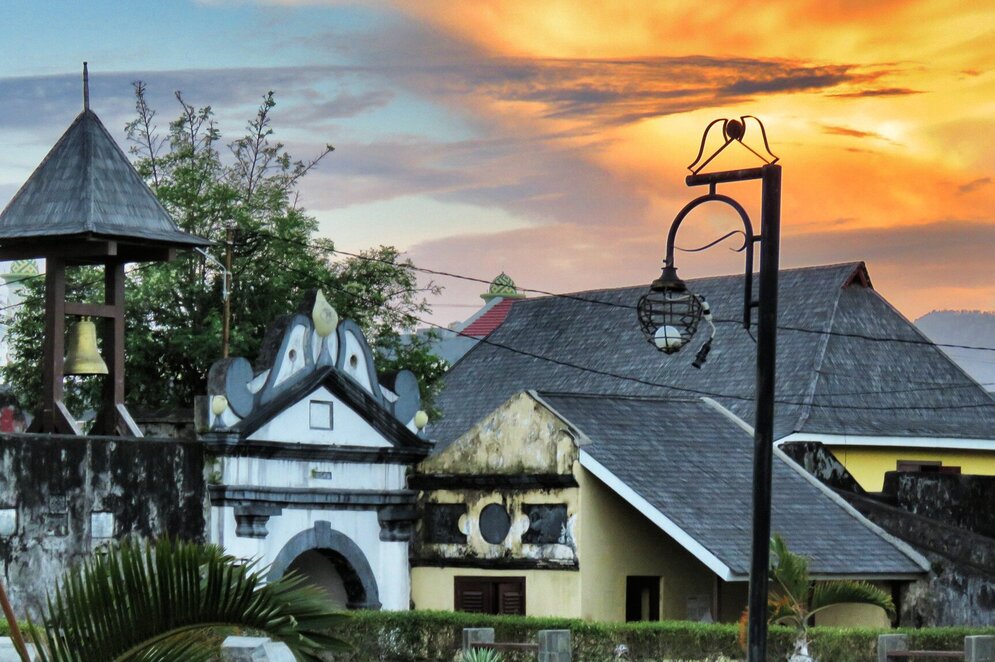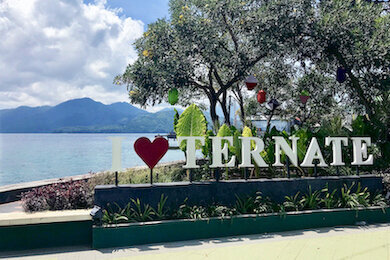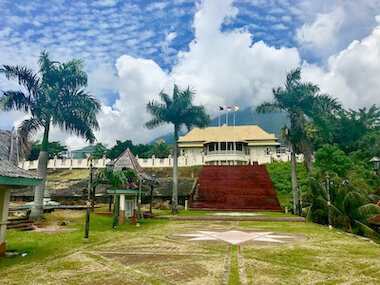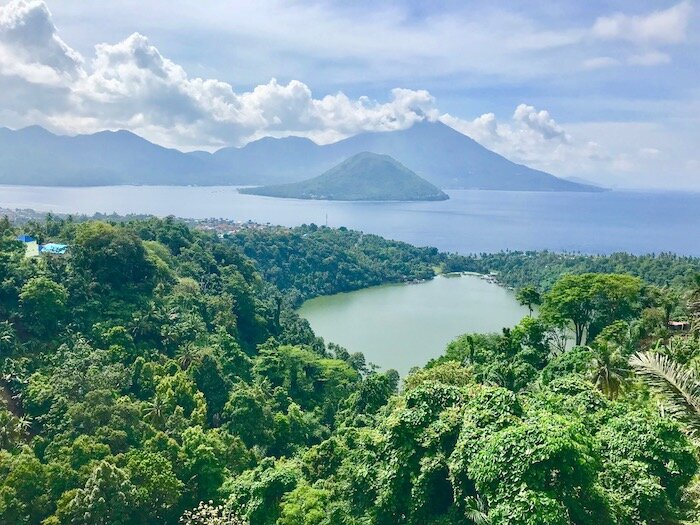The Spice Island Ternate
Fortresses, crater lakes and great viewsAs part of the Maritime Silk Road, the island of Ternate was an established anchor point for a wide range of cultures long before Europeans arrived. Thanks to its geographical and climatic coordinates, the island is one of the few places in the world that is home to the Myristica Fragrans and the Caryophyllus Aromaticus, the fruits of which we know as nutmeg and clove. Their trade shaped Ternate’s destiny for many centuries, so much so that the region around the island came to be known as the ‘Spice Islands’.
With an area of around 111 km², Ternate is a rather small island, but densely populated and with a lot of sights. Reflecting its turbulent history, the ruins of old fortifications left behind by the Portuguese, Spaniards and Dutch can be explored. The spice plantations of nutmeg, cinnamon and cloves on the slopes of the volcanic mountain Gamalama evoke times long past and provide wonderful shady viewpoints of the magical island world.
What you should see on Ternate Island:
- Ternate: As an important trading center for centuries, Ternate attracted people from near and far from early on. Quite a few stayed. To this day, Ternate plays a central role in the region and, thanks to good transport connections and its proximity to Manado, Sulawesi, is the gateway for travel to the province of North Maluku.
- Crater lakes on Ternate: Picturesquely presented, the crater lakes are waiting for you to explore on an island tour. Simply magical!
- Forts on Ternate: Are you interested in the legacy of the past? Built in colonial times to control the spice trade in the region, in Ternate you will find the remains of some old forts left by the Spanish, Portuguese and Dutch. Their fragile charm is reminiscent of times long past and the enormous importance that the Spice Islands once had...a magical journey into the past of the Moluccas.
- The Little Sultanate of Ternate: Did you know? The Sultanate of Ternate is one of the oldest sultanates in Indonesia and Ternate's Royal Family still plays a key role in the island's events today. However, the kingdom is currently without a ruler as Sultan Mudaffar Sjah died in 2015 and his successor has not yet been decided. It remains exciting.
- Beaches and snorkeling: Nestled in small bays and immersed in crystal-clear water, Ternate's short, dark sandy beaches invite you to swim and snorkel. In addition to the cozy atmosphere, you can also enjoy great island views. Because of the dark beaches and hot sand, pack a pair of bathing shoes as a precaution.
- Ternate's picnic areas: No matter where you stop, you'll always have a wonderful view: Ternate isn't a particularly large island, but it's not at a loss for impressive picnic areas. An island tour of the local sights should therefore definitely include a photo stop at one or another viewpoint in your program. Away from the hustle and bustle of the island's capital and up the slopes of Gamalama, wonderful views always open up that invite you to linger.
- Ternate and its volcanic local mountain: Ternate's local mountain, Gunung Gamalama, is actually a stratovolcano rising from the sea, which over time became an island. Gamalama is an active volcano and signs of previous activity are clearly visible in the island's appearance. Do you dare to climb it?
- Mosques on Ternate: Although a large number of different ethnic groups are based here, Ternate is still a predominantly Muslim island. Depending on its population density, there are numerous mosques that enable believers to practice their religion.
- Ternate: Island of spirituality: Although Islam plays a central role as a religion, everyday life is no less often accompanied by long-standing spiritually influenced traditions. Your trip to Ternate, the Moluccas, is a journey into another world!
- Cengkeh Afo – the oldest carnation tree: How it smells! As the island of origin of the clove, there are still numerous clove plantations on Ternate today. Three of the world's oldest clove trees, locally: Cengkeh Afo, are found hidden in one of the slopes of Gamalama. The trio miraculously survived the deforestation carried out by the Dutch East India Company. Visit a spice garden and don't forget to buy some spices for home.
- Everyday life on the island of Ternate: Perhaps surprising, but Ternate is densely populated and its streets are very busy, giving the island a busy appearance - untypical of the rest of the North Moluccas. Accordingly, small stalls can be found everywhere, shaping the streetscape with their offerings.
Book your tour to Deine Ternate with us
Impressions of Ternate
-

-

-

-

-

-

A mystical story from Ternate
The Legend of Mount Gamalama
The inhabitants of the island of Ternate believed that the volcano Gamalama was the guardian of the island, and they worshipped the mountain as a spiritual centre and asked for its support and benevolence in good and bad times.
It is said that a young boy named Malik was led to the Gamalama volcano. A bird, a messenger of the gods, revealed to Malik that Gamalama was a source of wisdom and happiness and taught Malik the secrets of balance, love and respect for nature.
To this day, the Gamalama is a sacred place and a symbol of the wisdom that lives on in the hearts of the people of Ternate.
Speaking of mystical stories from Ternate: Ternate's island history is full of them. Visit one of the festivals on the spice island of Ternate!
Letters from Ternate
But it is not just myths and legends that surround Ternate. In 1858, the naturalist Alfred Russel Wallace wrote an important letter to Charles Darwin from the island of Ternate, which made a decisive contribution to the development of the theory of evolution. Wallace was travelling in Southeast Asia at the time, exploring the animal world. In his letter to Darwin, he described a theory of natural selection that he had developed during his research.
Here is an extract from the letter Wallace sent to Darwin:
My dear Mr Darwin,
... The attention which I have devoted to the study of the distribution and variation of species in the different islands of this region has led me to some conclusions which I wish to communicate to you, as I think they are of some interest.
In general terms, my theory boils down to the fact that in a species with sufficient time and space for variation and natural selection, the one that best adapts to local circumstances will eventually give rise to a new species…
In this letter, Wallace essentially described the concept of natural selection that he had developed during his studies on Ternate. Darwin was so impressed by Wallace's work that he decided to present the joint research results in a joint publication, together with a brief summary of his own work, which essentially covered the same principles. This led to the famous ‘On the Tendency of Species to form Varieties; and on the Perpetuation of Varieties and Species by Natural Means of Selection’ in 1858.
Are you interested in a research trip to the East of Wallace? Are you a scientist or an ornithologist interested in rare bird species? Then get in touch with us!
Journey to Ternate
By plane:
- Singapur – Manado (Sulawesi) – Ternate –> Scoot 4 hrs. + u.a. Garuda, Wings 45 min.
- Jakarta (Java) – Ternate –> among others Garuda, Wings, LionAir, Batik 4 hrs.
By ship:
- Bitung (Sulawesi) – Bastiong (Ternate) –> 18 hrs.
- Jailolo (Halmahera) – Mangga Dua (Ternate) –> 60 min.
- Sofifi (Halmahera) – Mangga Dua (Ternate) –> 45 min.
- Rum (Tidore) – Mangga Dua (Ternate) –> 10 min.



